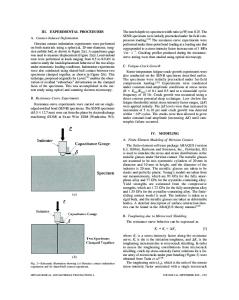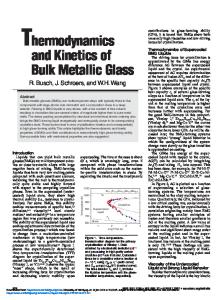Deformation and fracture behavior of tungsten fiber-reinforced bulk metallic glass composite subjected to transverse loa
- PDF / 375,434 Bytes
- 10 Pages / 612 x 792 pts (letter) Page_size
- 94 Downloads / 351 Views
K.Q. Qiu School of Materials Science and Engineering, Shenyang University of Technology, 110023 Shenyang, People’s Republic of China
X.F. Pan Shenyang National Laboratory for Materials Science, Institute of Metal Research, Chinese Academy of Sciences, Shenyang 110016, People’s Republic of China; and School of Materials Science and Engineering, Tianjin University, Tianjin 300072, People’s Republic of China
H.F. Zhang and Z.G. Wang Shenyang National Laboratory for Materials Science, Institute of Metal Research, Chinese Academy of Sciences, Shenyang 110016, People’s Republic of China (Received 23 August 2005; accepted 12 December 2005)
Deformation and fracture behavior of Zr41.25Ti13.75Ni10Cu12.5Be22.5 bulk metallic glass and its composite containing transverse tungsten fibers in compression were investigated. The monolithic metallic glass and the tungsten fiber composite specimens with aspect ratios of 2 and 1 are shown to have essentially the same ultimate strength under compression. The damage processes in the bulk metallic glass composite consisted of fiber cracking, followed by initiation of shear band in the glassy matrix mainly from the impingement of the fiber crack on the fiber/matrix interface. The site of the shear band initiation in the matrix is consistent with the prediction of finite element modeling. Evidence is present that the tungsten fiber can resist the propagation of the shear band in the glassy matrix. However, the compressive strain to failure substantially decreased in the present composite compared with the composites containing longitudinal tungsten fibers. Finally, the two composite specimens fractured in a shear mode and almost all the tungsten fibers contained cracks. I. INTRODUCTION
Bulk metallic glasses (BMGs) have been the subject of widespread research in recent years because of their exceptional mechanical properties, such as very high fracture strength, high hardness, and low Young’s moduli.1–4 In addition, fracture toughness and fatigue crack-growth behavior of some Zr-based BMGs are similar to those of ductile alloys.5–10 Despite these ductile features, BMGs usually exhibit little or no plasticity under uniaxial tension or compression at room temperature. Deformation of these materials is highly localized in a few shear bands, and final failure occurs by the propagation of a single dominant shear band.4,11,12 In the past decade, mechanical properties associated with shear band formation in BMGs have attracted much attention.13–15 Under highly confined conditions, these materials exhibit ductility as a result of the formation of multiple shear bands, a)
Address all correspondence to this author. e-mail: [email protected] DOI: 10.1557/JMR.2006.0169 J. Mater. Res., Vol. 21, No. 6, Jun 2006
http://journals.cambridge.org
Downloaded: 02 Dec 2014
which accommodate deformation without catastrophic failure.13,16–18 Large plastic strain associated with the formation of multiple shear bands has been observed in metallic glass plates subjected to bending or in the specimens with small-
Data Loading...











